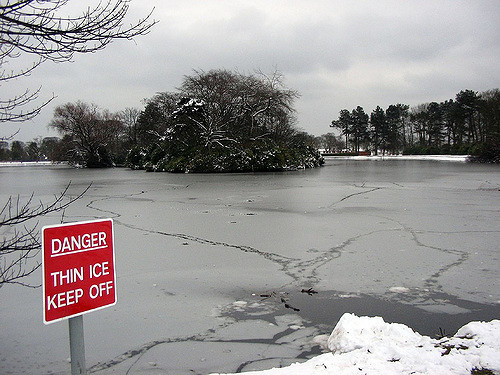
When is Ice Safe?

Last week’s cold weather led to the development of ice on some of the ponds and lakes across Cape Cod. However, several days of above freezing temperatures and rain has compromised any safety the ice once had. Residents are advised to avoid heading out onto any frozen body of water in the area.
This is a good time to think about “ice safety.” The following ice safety information is provided by Minnesota Department of Natural Resources and NOAA’s National Weather Service.
From the Minnesota DNR:
When is ice safe?
There really is no sure answer. You can’t judge the strength of ice just by its appearance, age, thickness, temperature, or whether or not the ice is covered with snow. Strength is based on all these factors — plus the depth of water under the ice, size of the water body, water chemistry and currents, the distribution of the load on the ice, and local climatic conditions.
From the National Weather Service:
Ice on lakes and streams can be deadly.
Before fishing, skiing, snowmobiling or engaging in any other activities on ice, check with local officials, such as your State Department of Natural Resources (or, in the case of Cape Cod, your local police and fire departments), who may monitor the body of water. If you see any of the following conditions, do NOT go out on the ice:
- Cracks, holes or breaks in the ice
- Flowing water around the edges, just below the surface, or over the top of the ice
- Ice that appears to have thawed and refrozen
If you decide to venture out on the ice, remember the following guidelines:
- Stay off the ice if it is less than 2 inches thick!
- For ice fishing, ice skating and walking, you need 4 inches or more of ice.
- For snowmobiles and ATVs, you need at least 5 inches.
- To drive a car or small pickup on ice you need at least 8 to 12 inches of ice.
- For medium-sized trucks, there must be at least 12 to 15 inches.
White or “snow” ice is only about half as strong as new, clear ice. Double these thickness guidelines when traveling on white ice. For more information on ice thickness and safety, visit mndnr.gov/icesafety



